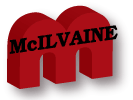
CATER Mask
Decisions
November 24, 2020
Millions of Lives Saved with Intelligent Mask
Program
Millions of Lives at Risk
Billions of Masks Needed to Achieve Herd
Immunity
Electrospun Nanofibers Available for CATE Masks
4C Air Supplies Nanofiber Based Masks for $3
Each
Dipole Providing Nanofiber Media for Military
Protection
Dipole Teaming with Gemstone Bio on Nanofiber
Media for Masks
Bionicia Supplies Electrospinning Equipment and
Does Contract Manufacturing
______________________________________________________________________________
Millions of Lives Saved with Intelligent Mask
Program
More than 55 million people have contracted
COVID-19 globally and 1.3 million have died.
More than 3 million more people will die in the
next 13 months unless policies change.
Many of these of lives can be saved by an
intelligent mask program. Acceleration of the
use of 93% rated CATE masks combined with
decreasing use of 49% rated CATE masks and
restrictions against 20% rated CATE masks are
what is needed. A combination of vaccines and
masks can provide the equivalent of herd
immunity (70%) by July of next year.
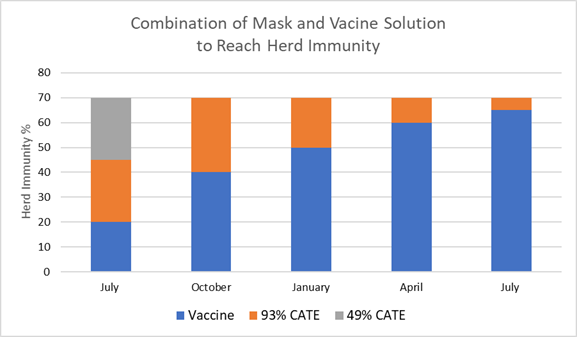
Experts are unanimous in their belief that masks
can save millions of lives in the next 13
months. But this is like saying that drugs can
save millions of lives. This statement may be
true but only if the right masks are worn. Some
masks provide no protection. The belief that
these masks capture large cough and sneeze
droplets is valid but there are two big
problems.
·
Most virus is
transmitted in small droplets through breathing
and talking
·
Large droplets
temporarily captured evaporate and transmit the
virus on a delayed basis
The idea that all masks are created equal has
been as responsible for infections as the idea
that masks are not important or that mandates
unfairly violate civil rights. It is therefore
imperative that the public understand
differences between masks and wear ones which
provide protection as well as reduce
transmission.
There are four aspects of masks which are
important.
·
Comfort: People
will not wear masks all day if they are not
comfortable.
·
Attractiveness:
As a major article of clothing an
attractive mask will be used more than an
unattractive one.
·
Tight Fit:
It is very difficult to achieve a tight.
But if 50% of the air leaks around the mask 50%
of the virus will as well.
·
Efficiency: Many
masks claim high removal efficiency on viruses
which are the size of perfume or smoke. But
unless valid performance tests are available the
efficiency is questionable.
These four important aspects form an acronym.
CATE masks are what every person will want to
have. There are many reusable versions of CATE
masks which make them affordable even it the
initial price is 30 times that of a disposable
mask.
If everyone were to start wearing masks with a
93% CATE rating tomorrow most of the
transmission would stop and millions of lives
would be saved. This may not be possible
immediately. But within six months everyone
could have 93% rated CATE masks.
In the meantime there are sufficient 49%
rated CATE masks to be used where the 93% rated
masks are not available. It will be equally
important to warn people against using masks
with a rating below 20%. They provide access to
restricted areas and therefore result in more
infections than if they were not available
So governments who are already mandating masks
have to clarify
their policies. They should provide
guidance which minimizes restrictions for those
with 93% rated masks. The guidance should
provide more limited access to those with 49%
rated CATE masks. They should prohibit access to
those with 20% rated CATE masks as they now do
for people with no masks.
Since CATE masks are reusable the cost per
wearing is low. The fastest and best way to
implement this program is not through government
purchases but just through guidance and
stipulations regarding mask use. The funding can
be part of the general support programs already
available in most countries.
The private sector has the capability to quickly
ramp up production. This can be done cost
effectively even though the market will surge
and then shrink in 2022. The key is use of
materials and resources already supplied in
other markets. So this becomes just one more
application for a product rather than the sole
market. Even with billions of people wearing
reusable masks the weight of non wovens
being consumed will be tiny compared to diapers,
wipes, or other high volume products.
The technology is also highly developed.
93% CATE masks have been used for years
for air pollution protection, wildfires, pollen
and immune depressed conditions
Millions of Lives at Risk
The death toll in the United States, currently
at 244,250, could nearly double by March 1 to
438,971, the Institute
for Health Metrics and Evaluation (IMHE) at
the University of Washington’s School of
Medicine forecasted in its latest projection.
Add Europe, which is in the midst of a second
wave of infections, and the rest of the world,
and the global death toll could reach a
staggering 2.8 million by March 1, the
IMHE projected.
“When
you see that Europe is already up to 4,000-plus
deaths a day, and it just keeps growing. We’re
on a similar trajectory,” Dr. Christopher
Murray, a professor of health metrics sciences
at the University of Washington and director of
the IHME, told NBC News. “We’re just about four
weeks behind."
More than a half million
lives could be lost to COVID-19 by 28 February
2021 in the USA, suggests a modeling study
published in Nature Medicine. The paper
also estimates that universal mask use could
prevent the worst effects of epidemic
resurgences in many states and could save nearly
130,000 of those half million lives.
The first major impact of
vaccines will be in the second quarter 2020. So
by July 1, 2021 twenty percent of the world
could be vaccinated.
This could reach 50% by the end of 2021.
By that point in time the U.S. deaths
could reach 800,000 or more. World death tolls
could reach 5 million people.
Billions of Masks Needed to Achieve Herd
Immunity
CATE is an acronym for Comfortable, Attractive,
Tight Fitting, Efficient. These masks have been
available for many years to combat air
pollution, wildfires and pollen. they are the
ideal selection for the general public in the
fight against COVID. Here are the numbers.
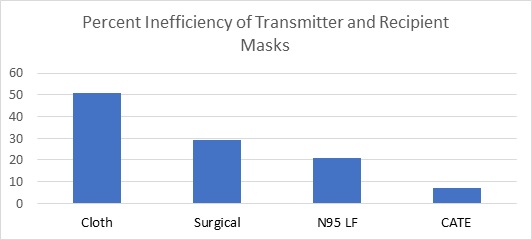
In
a room where people are social distancing at six
feet and MERV 8 filters are used in an HVAC
system with three air changes per hour unmasked
individuals will be generating a cloud of virus
particles similar to perfume or cigarette smoke.
If masks are worn by transmitters as well as
recipients, the net protection is a combination
of the performance of both masks.
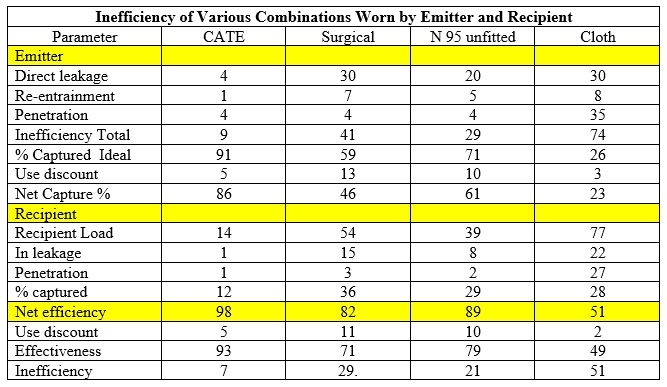
The net effectiveness is a function of the
potential capability of the mask minus failure
to achieve a tight fit and periods where the
mask is discarded due to discomfort or social
drivers. When all is considered the CATE mask
combination is 93% effective compared to only
49% for the cloth mask.
Mask type: CATE masks are generally reusable and
have various features to make them
attractive, tight fitting and comfortable as
well as efficient. Surgical masks are efficient
but not tight fitting. N95 masks can be
fitted for a tight seal but when worn by general
public they are often not used properly.
Cloth masks can excel in comfort and
attractiveness but are loose fitting and
inefficient.
Direct Leakage: This is the amount of air which
is exhaled around the mask directly.
Re-entrainment: Droplets initially captured on
masks evaporate and split causing virus to
escape.
Penetration: This relates to the efficiency of
the filter media.
Use Discount: Masks should be worn as
appropriate. Cloth and CAT masks are more
comfortable than the others and are more likely
to be used in borderline situations.
Recipient Load: This is the virus escaping the
transmitter mask.
In
Leakage: This is the amount inhaled around the
mask seals.
There is no question that tight fitting
efficient masks are the most effective weapon
against COVID. These masks prevented any
U.S. medical staff fighting Ebola to become
infected. The COVID incidence among medical
personnel in high COVID environments is very
low. In cases where these personnel had no
choice but loose fitting surgical masks the
infection rate was high. If a comfortable,
attractive version is available to the general
public the battle can be easily won.
A combination of masks and vaccinations can
create herd immunity quickly. It will be a
combination of CATE, surgical and medium
efficiency cloth masks. It will not include
inefficient cloth masks.
Because CATE masks are tight flitting,
efficient, comfortable and attractive they will
be 93% effective where utilized. It was
determined that only 1 mask would be needed per
quarter due to reusability.
This will be the most cost effective
option.
|
Quarterly CATE Masks Needed to Reach 70% Herd Immunity |
||||||
|
Date |
Cumulative % Vaccinated |
Add % to Reach 70 |
Mask Inefficiency |
% Needing Masks |
People Needing Masks Millions |
Masks Millions 1/person |
|
July 1, 2021 |
20 |
50 |
7 |
54 |
3,225 |
3,225 |
|
Oct. 1, 2021 |
40 |
30 |
7 |
32 |
1,920 |
1,920 |
|
Jan. 1, 2022 |
50 |
20 |
7 |
22 |
1,320 |
1,320 |
|
April 1, 2022 |
60 |
10 |
7 |
11 |
660 |
660 |
|
July 1, 2022 |
65 |
5 |
7 |
5.4 |
323 |
323 |
The surgical masks have high filtration
efficiency but lots of leakage. The assumption
is that the usage will be just one per day or 90
per quarter. To meet the needs of the world on
July 1 2021 with 20% of the 6 billion active
people vaccinated there would be a demand for
378 billion masks per quarter. This reduces to
just under 38 billion by July of 2022. Since
meltblowns are typically used in surgical masks
and there is a big investment and delay in
building new melt blown lines it is very
unlikely that the suppliers would or could gear
up for a market which will peak in the next year
and then shrink substantially.
|
Quarterly Surgical Masks Needed to Achieve 70% Herd Immunity |
||||||
|
Date |
Cumulative % Vaccinated |
Add % to Reach 70 |
Mask Inefficiency |
% Needing Masks |
People Needing Masks millions |
Masks Millions 90/person |
|
July 1, 2021 |
20 |
50 |
29 |
70 |
4,200 |
378,000 |
|
Oct. 1, 2021 |
40 |
30 |
29 |
42 |
2,520 |
226,800 |
|
Jan. 1, 2022 |
50 |
20 |
29 |
28 |
1,680 |
151,200 |
|
April 1, 2022 |
60 |
10 |
29 |
14 |
840 |
75,600 |
|
July 1, 2022 |
65 |
5 |
29 |
7 |
420 |
37,800 |
The cloth masks range in efficiency. In the
example below we have selected relatively
efficient designs. Many would have a 90%
inefficiency rating. We have selected reusable
masks in the $15-30 price range.
Even with a 51% inefficiency rating it
would not be possible to achieve herd immunity
with only 20% of the people vaccinated. You
would need to mask 102% of the active
population.
|
Quarterly Cloth Masks Needed to Achieve 70% Herd Immunity |
||||||
|
Date |
Cumulative % Vaccinated |
Add % to Reach 70% |
Mask Inefficiency |
% Needing Masks |
People Needing Masks millions |
Masks Millions 1/person |
|
July 1, 2021 |
20 |
50 |
51 |
102 |
6,120 |
6,120 |
|
Oct. 1, 2021 |
40 |
30 |
51 |
61 |
3,660 |
3,660 |
|
Jan. 1, 2022 |
50 |
20 |
51 |
41 |
2,460 |
2,460 |
|
April 1, 2022 |
60 |
10 |
51 |
20 |
1,200 |
1,200 |
|
July 1, 2022 |
65 |
5 |
51 |
10 |
612 |
612 |
Herd immunity could be achieved by July 2022 if
10% of the active people are wearing cloth masks
and 65% are protected through vaccinations.
However of the 5% who are not vaccinated,
probably half are in fear of side effects. These
people will be ones who will want CATE masks
rather than cloth masks because of the higher
protection.
Because of the huge immediate needs quick herd
immunity will only take place with some mix of
CATE, Surgical, and Cloth masks. But it is
achievable. The Biden Administration is
considering a mask mandate. Many countries
already have them. The problem is that without
specifying effectiveness some people are wearing
masks which provide almost no protection.
One way to achieve herd immunity would be to
specify CATE masks for those who are at most
risk and allow surgical and cloth masks for
others. However, for those masks with lower
effectiveness some specification must be set. It
should be some combination of maximum
penetration plus leakage. Europe has some
community mask specifications set around 80%
efficient media. However without fit being
included the specifications are inadequate.
The requirements can be based on expected load
factors. CATE masks could be required in subways
and theaters. Lower efficiency levels could be
allowed for walking suburban streets or in
grocery stores which have HEPA filtration and
laminar air flow at checkout counters. This
means that people may carry several masks and
use the one appropriate for the setting.
The requirements can be synchronized with the
production capabilities of suppliers. If the
guidelines are set appropriately, we could have
herd immunity in six months and save many
hundreds of thousands of lives.
Electrospun Nanofibers Available for CATE Masks
Fernando Gomollón-Bel, a freelance writer based
in Cambridge, England interviewed some nanofiber
producers for an article in Chemical and
Engineering News. Excerpts are show below.
Subsequent articles provide more information on
the companies interviewed based on McIlvaine
research. The Alerts have many articles on a
number of producers but some of the producers
quoted in this article have not been previously
analyzed
“Electrospinning is like making spaghetti but
using electricity to help us pull,” says Yi Cui,
a professor of materials science at Stanford
University and cofounder of 4C Air, a start-up
that manufactures air filtration systems based
on nanomaterials. The technology is not new.
Electrospinning was discovered in the 1930s, and
“it has been used to make nanofibers for
decades,” Cui says. But the pandemic has created
a new market.
4C Air was originally formed to develop a
material to tackle air pollution. “Fine
particles are extremely dangerous, even more
than officially recognized,” says Steven Chu, a
cofounder of the firm and a Nobel laureate in
physics. Chu and Cui say the firm’s
nanomaterials filter these fine particles
exceptionally well. And since the aerosol
droplets that disperse the novel coronavirus are
similar in size, they saw a new opportunity.
Maryland-based DiPole
Materials also specializes in making custom
nanofibers. When the pandemic struck the US, the
firm redesigned most of its processes. “We soon
started working hand in hand with people that
needed our help,” DiPole CEO Ken Malone says.
“Had it not been for COVID, we probably wouldn’t
be in the filter business.”
Nanofibers make good filters
mostly because of two factors: mechanical and
electrostatic interactions with aerosol
particles. Richard L. Corsi, an expert in indoor
air quality at Portland State University,
compares mechanical filtration to spaceships
flying chaotically through a forest.
“It is like those epic
battles in Star Wars,” he says. “If there are
many trees along the way, the ships are more
likely to crash.” And if the trees are
disorganized and entangled with branches, they
are harder to dodge.
For this reason, nonwoven
fabrics—such as those obtained by
electrospinning—are more efficient at
intercepting small particles. On top of that,
nanofibers have higher adsorption surface areas,
giving them a greater ability to capture
droplets and particles.
The electrostatic
charge imparted by electrospinning also
plays a role in how nanofibers filter aerosols.
“These interactions give the extra boost to
remove additional particles,” Corsi says.
Traditional N95 masks also rely partly on
electrostatics. They are made with dielectric
microfibers that maintain a surface charge for
long periods of time, and aerosol droplets stick
to them like pieces of paper to a balloon. But
Cui argues that this effect is more pronounced
with electrospun nanofibers.
“When you go to small particles and small
fibers, the [electrostatic] effect begins to
play an increasingly important role,” he says.
Cui points to independent testing that shows
that the firm’s products effectively filter the
most penetrating aerosol particles. 4C Air says
all its nanofiber masks have been tested by the
US National Institute for Occupational Safety
and Health and received the N95
certification—meaning they filter at least 95%
of airborne particles.
Nanofibers also make masks more comfortable.
“They allow more air to pass with the same
filtration efficiency,” says Scott R. Gaboury,
chief operating officer of DiPole. The main
reason for this is physics—specifically, the
resistance that the air meets when flowing
through the mask, commonly known as pressure
drop.
Usually, the higher the filtration efficiency,
the higher the pressure drop, which makes the
most secure masks, such as N95s, less
breathable. However, pressure drop is inversely
proportional to the surface area of filter
fibers, which is a plus for nanofibers. “We have
measured many brands, and usually the pressure
drop is over 100 pascals,” Cui says. 4C Air’s
masks reduce that resistance by up to 60%. “The
breathability is just incredible,” he says.
The Spanish start-up Bioinicia, which also makes
masks using electrospinning, has similar claims
on its website. Apart from enhanced
breathability, its nanofibers dissipate humidity
and heat better than traditional fabrics, the
firm says. Water droplets created by
condensation can dissipate the static charges on
the nanofibers and make them less effective
filters. Long-lasting charge makes for
long-lasting masks, Cui says. “For regular use,
you can probably wear our masks for two weeks
without losing any efficiency,” he says.
Beyond masks, the electrospinning firms are
developing other types of protective equipment.
4C Air’s original business is making window
screens to filter fine particles, including
pollen and pollution.
DiPole Materials is creating a variety of custom-made
products for local groups and businesses.
Rather than masks, the firm manufactures pieces
of fabric that snap into 3-D printed plastic
mask frames or can be inserted into cloth
masks. It’s working with the University of
Maryland Medical Center to develop a specialty
mask designed by doctors. And it recently signed
an agreement with the US Army to create new
nanofiber composites for air filtration.
So far, these companies operate on a small
scale, particularly DiPole, which has limited
production capacity and has fabricated enough
material for only around half a million masks.
“Technically, scaling up electrospinning is not
difficult, but we prefer to focus on creating
specialty products and synthesizing unique
nanofibers on demand,” Gaboury says. Although
big multibillion-dollar companies have knocked
on DiPole’s door, the firm kept filter supply
local, he says.
4C Air runs a pilot line in the US and two
production lines in China. “We can afford a
small production of 2 million masks per month,”
Cui says. Bioinicia said in July that it hoped
to be making 11 million masks per week by now
and expanding beyond Europe. The firm didn’t
respond to interview requests.
Big mask makers like 3M have not embraced
electrospinning; their established techniques
are well entrenched and investing in new
technologies is risky. In terms of air
filtration, it’s safe to stick to proven
technologies, Corsi points out. “It is amazing
how even very simple masks can help us prevent
the spread of the virus.”
Executives at electrospun-fiber firms are aware
that masks based on their materials will remain
niche items during the COVID-19 pandemic. But
they are watching a longer time horizon. “This
is unlikely to be the last pandemic,” Chu says,
and nanofibers could bring masks with “much
better protection and much more comfort.”
4C Air Supplies Nanofiber Based Masks for $3
Each
Air 4C Air has collaborated with AireTech Clean
Technology to produce the Nano-Media KN95
Particulate Mask with 4C Air's BreSafe nanofiber
filtration media and filtration technology: a
nanofiber-based particulate mask that can filter
out 95% of dangerous particles, including fine
particulate matter from wildfires and harmful
germs. It is designed for ergonomic comfort
while meeting the high-quality needs of everyday
personal protection.
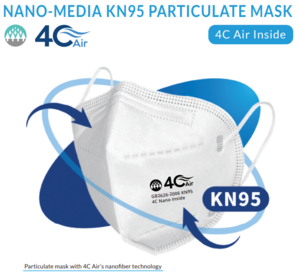
Effective against harmful smog from fires and
pollution, unlike cloth and medical masks
Five-layered mask for multiple particle blocking
sizes and comfort
High filtration efficiency (>95%) for 0.3
microns particles
Low breathing resistance compared to competitors
Certified KN95 (GB2626-2006, equivalent to NIOSH
N95)
Masks are sold on the 4C Air website at $3 per
mask in boxes of 25.
Dipole Providing Nanofiber Media for Military
Protection
DiPole Materials, an electrospinning company
that specializes in custom nanofiber
manufacturing, has entered into a Cooperative
Research and Development Agreement (CRADA) with
the US
Army Combat Capabilities Development Command
Chemical Biological Center (CCDC
Chemical Biological Center).
“The CCDC Chemical Biological Center technology
developments are very impressive, and we are
excited to collaborate with them to utilize
Dipole Materials’ capabilities in nanocomposites
fabrication for enhanced protection systems to
be used by US military personnel,” said Scott
Gaboury, CSO with DiPole Materials.
Under the terms of the CRADA, DiPole Materials
will utilize its expertise in nanofiber design
and manufacturing to develop composite fibers
from blends of polymers and inorganic materials
capable of abating various toxic chemicals.
These DiPole-manufactured composite fibers will
have the potential for use in a range of textile
materials that can provide enhanced chemical and
biological warfare protection for US Army
soldiers.
“Last year, when we partnered with the Maryland
Department of Commerce to form the Maryland
Defense Technology Commercialization Center (DefTech),
we wanted to help unlock the economic value of
the brilliant work going on in our state’s
military research facilities,” said Ken Malone,
CEO with DiPole Materials. “This CRADA is
another step in that direction and couldn’t have
happened without the help of DefTech.”
The CCDC Chemical Biological Center is the
nation’s principal R&D resource for chemical and
biological protection to US soldiers. The CCDC
Chemical Biological Center’s activities span the
life cycle of chemical and biological defense
research and product development.
Dipole Teaming with Gemstone Bio on Nanofiber
Media for Masks
DiPole Materials, an electrospinning company that specializes in custom nanofiber manufacturing, is teaming up with Gemstone Biotherapeutics, a biotech company developing novel, bioengineered products for scar-free skin regeneration, to rapidly accelerate production of filters to meet emergency demand for medical masks.
DiPole Materials’ and Gemstone Bio’s teams are
collaborating to manufacture cuts of continuous
roll-to-roll production of nanofiber filters.
This material then gets cut into small,
mouth-sized squares which are then mounted into
medical masks. Gemstone Bio’s expert team brings
its practical knowledge of Good Manufacturing
Practices and wet lab skills to help ensure and
maintain manufacturing quality controls.
“Our team is eager to contribute to the
production of materials needed now for rapidly
scaled medical mask manufacturing,” said Emily
English, PhD, CEO of Gemstone Bio. “Partnering
with DiPole Materials is seamless and
demonstrates the depth of Baltimore’s biotech
and advanced materials’ prowess. As a team, we
embraced the opportunity to help our region and
the nation during the crisis.”
DiPole Materials’ nanofiber filters are the type used in N95 respirators, which provide high end protection for critical medical needs. The combined teams are working with cut and sew shops, makers spaces and engineering companies in Maryland to integrate newly produced filters into their masks to increase the protection provided to healthcare workers and first responders.
“We couldn’t ask for better partners with Emily
and the Gemstone Bio team,” said Ken Malone,
Chairman of DiPole Materials. “Time is of the
essence in this crisis. With Gemstone Bio and
our other Baltimore partners, we’re able to ramp
up mask filter production and speed
manufacturing to get masks in the hands of
medical personnel.
“We’re seeing tremendous partnering among
manufacturers and maker communities in our
region to address the COVID-19 epidemic,” said
Ken Malone, Chairman of DiPole Materials. “We’re
eager to deploy our electrospinning
manufacturing capabilities to join in
accelerating production of critically needed
medical masks.”
Bionicia Supplies Electrospinning Equipment and
Does Contract Manufacturing
The company supplies electrospinning equipment
for a range of industries. This raises the
question whether some of the users could
temporarily switch to making mask materials.
The Fluidnatek LE-500 is an electrospinning
machine conceived to be a pilot-line production
tool that provides all of the capability needed
to develop a product from initial concept to
pilot-scale manufacture. With roll-to-roll
collection, large-volume solution reservoirs,
and high-throughput multi-emitter spinning
heads, the LE-500 is the ideal electrospinning
equipment for fabrication of pre-production
volumes of production-quality materials.
However, the LE-500 can be run either in R&D
mode or in manufacturing mode, that way being a
flexible electrospinning device as well.

